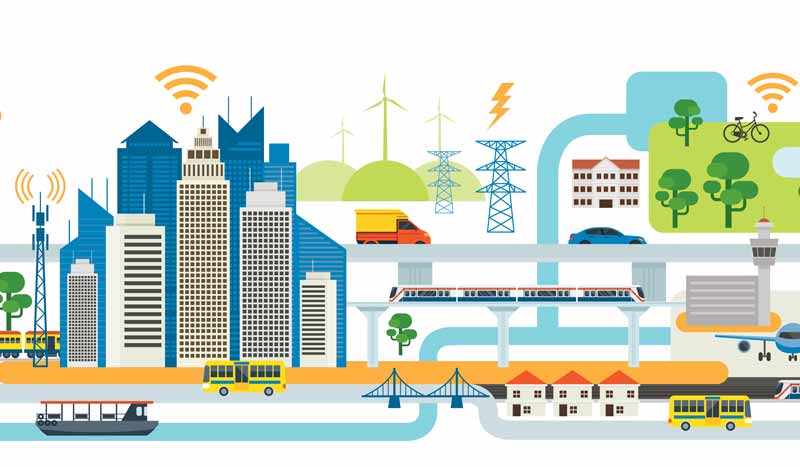
CONNECTED SPACES
Imagine a world so interconnected that at the tap of a touch screen, an app will show you everything you need to know about the status of your home, your business, your car, your kids and even the batch of laundry that you hung out to dry before leaving for work. Imagine having an app that reserves a parking spot for you even before you’ve reached the mall, or one that opens your front gate without you having to reach for a key. With the Internet of Things (IoT), you don’t have to imagine because that vision of the future is already here.
IoT technology is a network based technology that works by extending internet connectivity to traditionally ‘dumb’ devices and allow them to communicate through the Internet and broadcast data to a receiver or sensor. This data, once analysed and filtered through to a user-friendly application, would allow industries, businesses and even the direct consumer to know the exact status, location, and a multitude of other data, of any appliance, machinery or even person.
“All it takes is the placement of a single low-powered, low bandwidth device, be it in the glovebox of your car or in the form of a wristband, to connect to the network and start broadcasting data. It’s a simple, non- intrusive action and each device lasts between one to five years, so you can just leave it and forget it,†says Vicks Kanagasingam, the Chief Operating Officer of Xperanti IoT, the company at the forefront of making nationwide IoT connectivity a reality in Malaysia.
Xperanti has just opened up Malaysia to the powers of IoT, as it has officially launched the first nationwide IoT network last November. The infrastructure and network is deployed and ready to use, powered by Sigfox, a global IoT enablement company that has connectivity in more than 50 countries. The Xperanti network boasts a reach of more than 80 per cent of the countries population, including major cities in Sabah and Sarawak, and with names like Malaysia Airlines Holdings and Strand Aerospace already jumping on board, we’re bound to hear more about IoT as more and more companies adopt it.
IoT technology is a powerful solution for almost all industries, as service providers like SAP, Dell, Huawei and other big tech names are able to provide tailored and custom- built solutions for their clients.
If you’re a logistics company that delivers goods across the country, implementing IoT in your systems allows you to track the goods in transit that are updated in seconds and precise to the exact metre, as long as receivers are placed along the route to pick up signals from the broadcasting IoT-ready device that accompanies your goods. This ability extends globally too, so tracking goods as they cross borders would be much simpler for both the logistics company and the clients, provided that your network is supported in that country.
But that’s only just one way that IoT can be implemented and now that the possibilities are endless, industries such as security, logistics and storage, transportation, manufacturing, and even industries in the public sector, such as environmental monitoring, early warning systems or public health and transportation management, will benefit from the implementation of IoT in industries. Even in the hospitality sector, IoT is making waves in providing ease of access within the hotel, such as the integration of IoT in the villas of Joali Maldives resort, where everything, from lights to security, is accessed from a touchpad on the bedside.
So how does IoT technology fit into the city of the future? The keyword is efficiency. Let’s take the light rail system in Malaysia for example. It’s not uncommon that a slight delay on one train or a single malfunctioning signal light (as was the case in September 2018) would cause a butterfly effect that delays the entire transit system for hours, with the problem persisting over the span of a few days before being fixed. And in the case of a driverless system like our LRT and MRT public transportation, a single glitch in the programme affects the entire system. By the time a programmer
is called onto the scene to diagnose the problem, the issue would have already affected hundreds or even thousands of consumers in the short span of an hour. With IoT implementation on the rail system, problems like these could be easily prevented by closely monitoring the railway and the trains themselves to nip problems in the bud.
One such company at the forefront of railway Industrial IoT is KONUX Inc, a Munich-based company that specialises in predictive maintenance through the use of IoT integrated sensors that monitor trains and rail tracks and then analyses data using artificial intelligence (AI) fueled programmes that look out for weaknesses or potential malfunctions in the system, before packaging all that information in an easy to digest graphic application available to view at the touch of a screen. The AI pings out locations in the rail network that show abnormality, so that technicians can schedule maintenance and prevent unexpected breakdowns of the system. The economic benefits are plenty, as it saves on emergency repairs, but the positive effects on efficiency across sectors is what will truly be felt by all parties.


